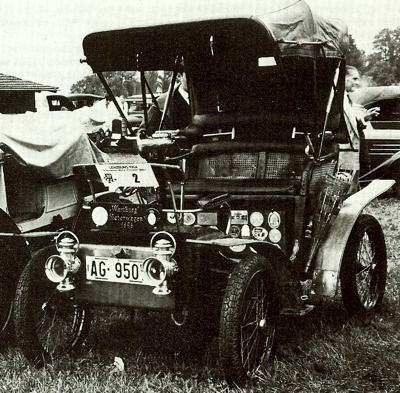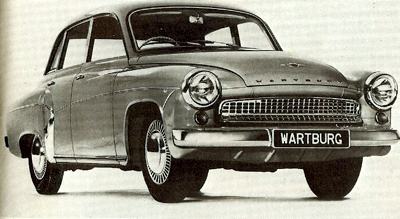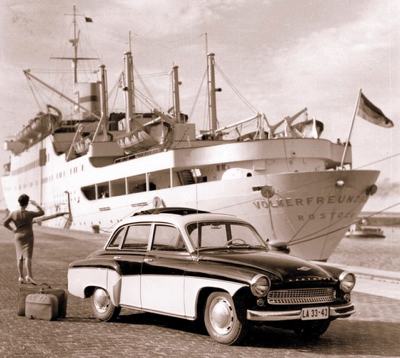|
Wartburg
|
1898
- 1991 |
Country: |
 |
|
Fahrzeugfabrik Eisenach AG
Unlike most car firms which grew despite uncertain and ill-financed beginnings, Wartburg had a comparatively easy start in life. The firm was founded on 3 December 1896, at Eisenach, in what was to become East Germany, as the Fahrzeugfabrik Eisenach AG, by a consortium of bankers headed by a Government architect, Heinrich Ehrhardt, with a capital of 1.25 million marks.
The 1898 Dusseldorf Motor Show
The firm's original purpose was to make military equipment, but growing interest in the motor car - by that time Daimler was manufacturing at Cannstadt and Benz at Mannheim - soon persuaded Ehrhardt to review his intentions. The firm had all the facilities for car manufacture, and signalled their intentions at the 1898 Dusseldorf Motor Show by exhibiting a prototype three-wheel De Dion-type vehicle fitted with a 4 hp twin cylinder Benz engine.
But Ehrhardt realised that the best way to get into the developing car market quickly was to go for a simple and proven design, so he hurried to France to find a suitable car to construct under licence. The most promising design appeared to be the small and uncomplicated Voiturelle being made by the Societe Decauville at Aine, Ehrhardt swiftly signed a licensing agreement, and production at Eisenach was under way within a year.
The Model 1 Wartburg Wagen
Dubbed the Model 1 Wartburg Wagen, the factory's first car had a rear-mounted air-cooled De Dion type petrol engine with two cylinders, each 66 mm bore x 70 mm stroke, giving a 479 cc capacity and producing 4 hp. A two-speed gearbox was fitted. A second model offered a 5 hp engine with water cooling by means of a front-mounted spiral tube, drive being through a three-speed gearbox. The comparative reliability of the lay-out of these cars, with the engine under the seat and driving the rigid rear axle direct, contributed to their considerable popularity, and large numbers were built.
Sold in the USA as Cosmobiles
Three 2-3 seat bodies were offered - the conventional Decauville style, a model with wicker-work seats and rear body suspension by C-springs, and finally an up-market version with wicker seats, extra upholstery in the rear, and a hood, and described as being 'a very comfortable and smart promenade vehicle of particular interest to ladies wishing to drive themselves'. Wartburg marketed strenuously among the European upper and upper-middle classes, and also exported here to the US, where Wartburgs were sold as Cosmobiles. Their good manners and reputation for being comparatively powerful was sustained in trials and races, notably the Saltzburg-Vienna, the Vienna-Graz-Vienna, and the Berlin-Aachen events.
Those early Wartburg cars also won a total of 22 first prizes and gold medals at various exhibitions. Their 764 cc engines with two cylinders produced 5 hp at about 1000 rpm, and were capable of 25 mph in road-going form. Ehrhardt may have been principally a businessman, but he was also keenly aware of the constant technological advance of the time, and in 1900 Wartburg cars forsook the horseless-carriage layout and adopted the new convention of front-mounted engine under an identifiable bonnet, four forward-facing seats, and longitudinal elliptical springs.
Engine output rose to 10 hp; and the twin-cylinder series culminated in 1903 with the unit installed in the front of the chassis frame but driving the rear axle via a leather cone friction clutch and propeller shaft. At the same time Wartburg moved into the four-cylinder bracket with a 15 hp engine with cylinders that were cast in pairs and displaced 3140 cc. Versions giving 40 and 45 hp followed. In 1904 Ehrhardt left the firm to manufacture cars under his own name at Dusseldorf and Zella-St Blasii. For the first two years he maintained the old Decauville connection, selling the design as Ehrhardt-Decauville cars, but in 1906 he built to his own design, and in 1913 produced a very exclusive 31/50 hp 8-liter which was the first German car with four-wheel brakes.
 The Wartburgwagen of 1898, the first Wartburg. It was powered by a De Dion 479cc engine.
The Wartburgwagen of 1898, the first Wartburg. It was powered by a De Dion 479cc engine.
 1966 Wartburg 1000, the last of the line before the Knight was introduced.
1966 Wartburg 1000, the last of the line before the Knight was introduced.
 |
Ehrhardt-Szawe
In 1922 the Ehrhardt firm merged with the Berlin Szawe firm of coach-builders who produced luxurious and highly-polished cars. Ehrhardt-Szawe cars were marketed until the firm expired in 1924 - during the economic depression. At Eisenach meanwhile the Wartburg name had fallen into disuse after Ehrhardt's departure, and cars were marketed under a new badge, Dixi, which because of its literal 'I have spoken' meaning colloquially implied that the cars were 'the last word' in motoring.
The Last Word in Motoring - Dixi
A wide variety of Dixi models were built from 1904 until World War 1. From 1904-7 the principal model was the Dixi S12, powered by a water-cooled four- cylinder engine, the cylinders cast in pairs, displacing 28 I 5 cc and giving 20 hp at a bout 1200 rpm. Top speed was around 40 mph. During 1905 more models were added, with one, two and four-cylinder engines from 1234 to 4920 cc. As Dixi did its share of experimenting, aT-Type series of chain-driven cars was produced ranging from the little single-cylinder T7 of 1234cc, through, twin-cylinder T12, 13 and 14 models all of 2468 cc, to the four-cylinder 4920 cc T24.
The S series extended from the 1408 cc twin-cylinder S6 and the 28 IS cc S12, S13 and S14 models, all of which, like the T-series represented little more than a series of permutations of cylinder line-up. Some of these cars, all fairly typical in appearance of the expensive cars of the day, were exported to France as Reginas and to Britain as Leander. From 1907 to 1910 a U-series was developed from the T -series. The U35 was the Dixi flagship. This U35 had four 125 x 150 mm cylinders, 7320 cc displacement, a 26/65 hp rating, and a top speed of 55 mph. A 6732 cc version was also built.
The Frankfurt Flying-Kilometre
Six body-styles were offered from two-seater sports to limousine with detachable top, and a 75 hp racing car was also produced in 1908. In that year an R8 model appeared, the firm's first small four-cylinder car with modest 74.5 x 90 mm pots, a 1558cc displacement and a 6/16hp rating. Because of its lightness, however, it had a 40 mph capability. A special lightweight R8 with sports body won its class in a Frankfurt flying-kilometre trial in 1909 with a speed of nearly 65 mph. R9, R12 and R18 models were also produced on the R8 theme and buses for up to 20 passengers were being built as well.
Merging with Gothaer Waggonfabrik
After the war the German car industry blundered uncertainly through the country's period of inflationary crisis. In the spring of 1921 the Eisenach operation was merged with the Gothaer Waggonfabrik railway coach firm, and the Dixi badge acquired a striding Centaur with flying mane. Eisenach produced R10, R12 and S16 cars with 6/24 and 13/30 hp ratings. A racing version of the 6/24 swept the board at the 1922 Avus Race, gaining first, second and fourth places. Also brought to production status at this time was a pre-war B1 design of small car of 1320cc producing 5/I4hp, and a three-seater boat-tailed RS was also developed.
Though these cars did not materialise into production models, the RS at least provided Dixi with some small-car experience to help the firm overcome its preoccupation with large cars. Several types of large car were being built, such as the 6/18 GI limousine of 1923, the 3.5-liter 60 hp six-cylinder six-seater limousine of 1925, and then the bigger 23 hp 70/5.8 liter car. None of these was particularly suited to the economic situation, and Dixi desperately wanted a viable small car. Though they developed one such, the Diana, with three-seater body and 763cc 3/12hp engine, it was felt that this model could not be got into production in time to meet Dixi's needs, and the firm reverted to Ehrhardt's original ploy - a licensing agreement to make a successful foreign model.
Building the Austin Seven
This time they came to Britain, going back with a licence to build the Austin Seven under their own name. In December 1927 the new Dixi DA 1 four-seater in sedan, drophead and coupe form went into production. In 1928 the factory built some 9300 of the DA 1, a telling contrast to the previous output of large and expensive cars. But the firm still lacked a profitable totally German product and was therefore vulnerable, and in 1928 the powerful motorcycle and aero-engine concern BMW acquired the Eisenach factory as part of its takeover of Gothaer and Dixi. BMW's history is well documented both on the Unique Cars and Parts US and Australian sites, but it is still necessary to note - in tracing the progress of the operation that started life as Wartburg and was to revert later to Wartburg - what happened at Eisenach under the BMW banner.
The new owners promptly picked up the old Wartburg name, in fact, using it for a two-seater 63mph sports model in 1931. Meanwhile the DA 1 was updated to become the BMW-Dixie. A total of 25,000 Dixis had been produced by the time the Austin agreement ran out In 1932. The design was then revised and Eisenach produced a series of four AM models with 800 cc 3/20 hp engines, swing axles front and rear, tubular backbone chassis and a larger body. Eisenach produced 7000 of these AM small cars from 1933. In the same year a six-cylinder 303 model with 1.2-liter engine was brought out, and 2500 were produced.
The Type 309 BMW
Up to 1939 Eisenach built 6000 of the 900cc Type 309 BMW, 10,000 of the six-cylinder 315, 7000 of the 319, 8000 of the 320/321 models, 16,000 of the Type 326, 200 of the famous 328 Sport, 2100 of the 327/328 saloons, 1200 of the 329, and in 1939/40 some 400 of the 335 - intended for the British market - before Europe was again plunged into war. In 1945 the Eisenach works yet again changed hands, this time through nationalisation. Management by a consortium called Awtovelo took up production of pre-war BMW cars, using the original BMW emblem.
In 1952 BMW 'proper' moved car production to its motorcycle factory at Munich, and the Eisenach operation got a new name, EMW (Eisenacher Motoren-Werke). The first EMW, the 321, was identical to the previous BMW, the firm's 327 was very close to the old pre-war BMW 2-liter, and the EMW 340/2 was based on the BMW 326. BMW designs were also used as a basis for sports and Formula Two racing cars known as AWE's (Automobilwerk Eisenach). This name was officially adopted in 1955 when production of BMW-based cars ceased.
The EMW IFA F9
It was in 1955 too that the factory took up production of a car based on a pre-war DKW design now known as the IFA F9 - IFA being the name of a nationalised combine of East German car factories, which included Eisenach. The F9 had a three-cylinder two-stroke 894 cc engine driving the front wheels, and an identifiable DKW look. But in 1956 this model gave way at Eisenach (where the company had changed its name yet again, this time to VEB Automobilwerk Eisenach) to one of similar mechanical specification but with a new body. And the new car was called the Wartburg.
The Wartburg Knight and Tourist
At first the Wartburg retained the 894 cc engine, which gave 40 hp in standard form and 50 hp in the sports version. These models took Eisenac postwar production past the 100,000 mark in 1957. Engine capacity was raised in 1962 to 991 cc and 45 hp, the new version being known as the Wartburg 1000. It was available with saloon and coupe bodies and in two different estate designs. The 1000 stayed in production until 1966 when a restyled car appeared - the Knight sedan. The wagon version of the sedan was known as the Tourist.
The 991 cc three-cylinder two-stroke engine was retained, but the new bodies were trim and modern. It was the Knight which brought Wartburg's name substantially to West European motoring public, and the car gained a following for its uncomplicated sturdiness, reasonable economy, and full specification at a low price - though the finish was widely regarded as utilitarian. The prices of Wartburg's remained comparatively low through the early 1970s when other makes were increasing substantially in price, and sales were beginning to mount considerably when in 1974, new European exhaust emission control regulations prevented further exports of Wartburgs.
The End of the 2 Stroke
The Wartburg was not imported into Britain after November 1974, although the importers had managed to stockpile the Knight in some numbers and sales continued into 1975. In its final specification the Knight had acquired a number of 'western' safety features such as impact-absorbing body design, heavily-padded facia and steering wheel, radial tyres, childproof rear door-locks, a pressure limiting valve on the rear brakes, and rear anti-roll bar. Adjustable-beam headlights, two-speed wipers, screen washer, through-flow ventilation, reclining front seats, cloth seat facings, twin reversing lamps and optional sunshine roof were also featured, showing that Eisenach was just as aware of what went on in terms of development elsewhere.
Regardless, production continued, and the Knight went from model to model, specifically as the:
- Wartburg 353 from 1966
- Wartburg 353W from 1977
- Wartburg 353W from 1983
- Wartburg 353 from 1986
Of these version, the De luxe was fitted with electronic igniton, 5 speed gearbox, front and back fog lights, alarm system and central lock door. The newer model had a four stroke modified engine from Volkswagen with 58 horsepower. The final nail in its coffin for Wartburg however was the introduction of the Deutschmark, as the cost of producing the car reached 20,000 DM. Production ended in 1991, as German reunification spelled its end. The factory was acquired by Opel in 1991.
Recommended Reading: Wartburg (AUS Edition) |
BMW Aero Engine History 